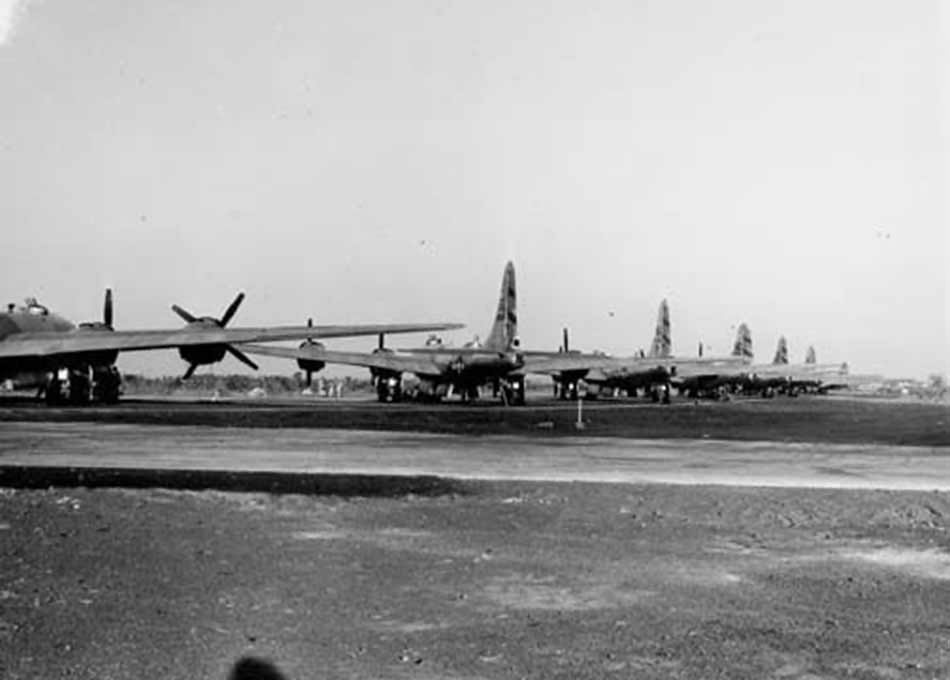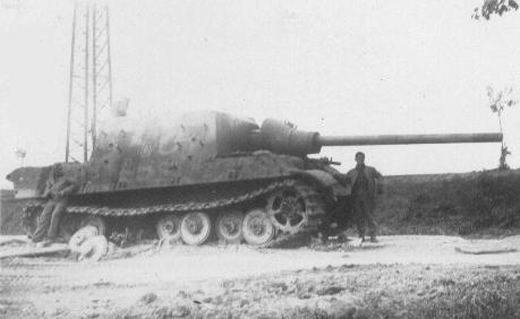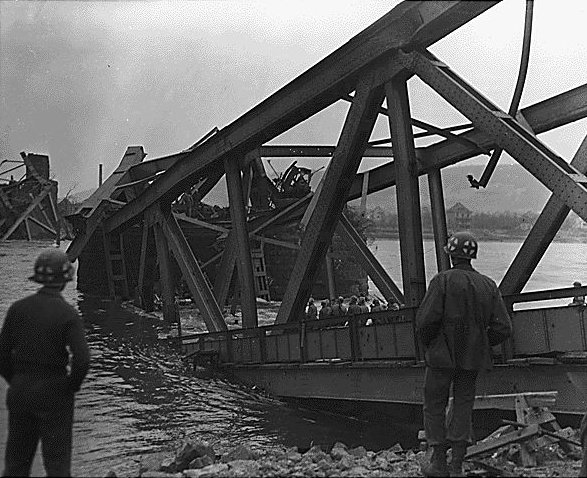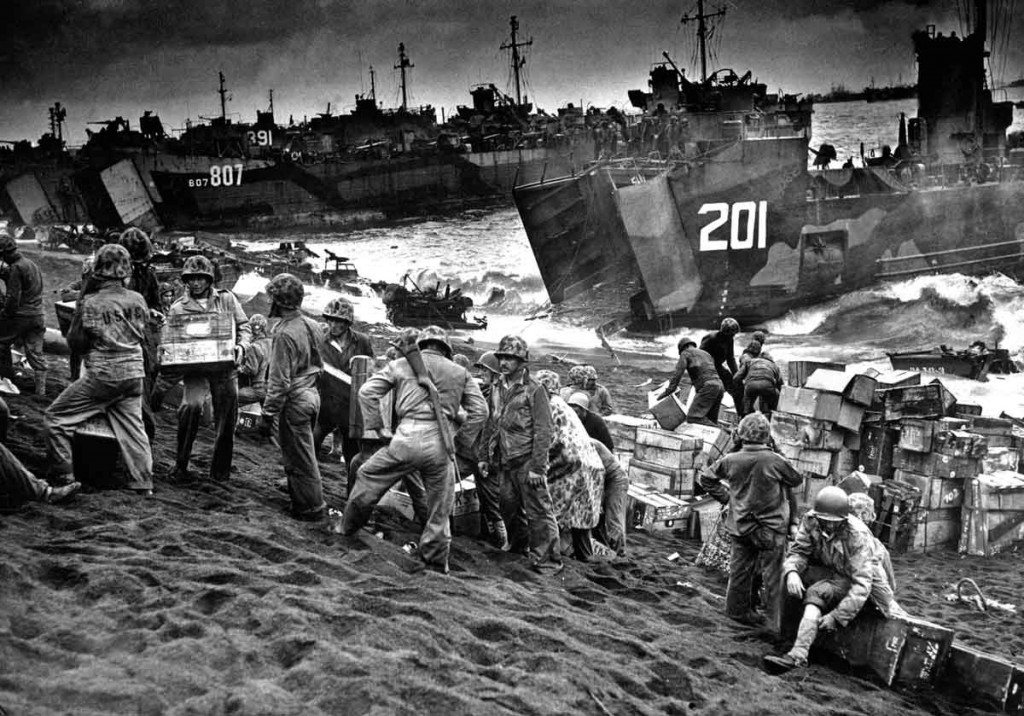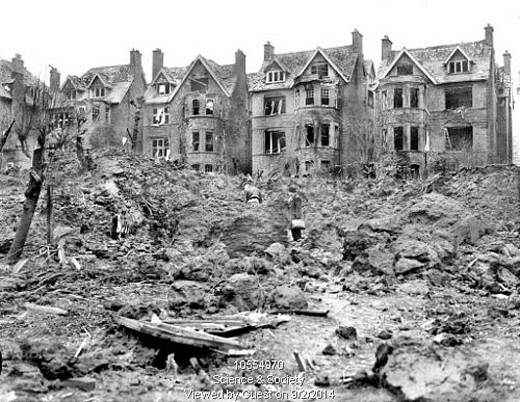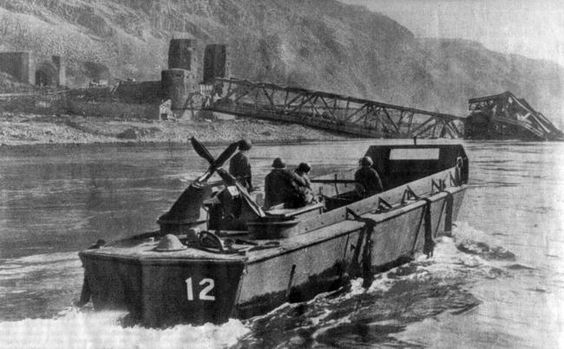Air Operations, CBI
BURMA- 70 of 77 58th Very Heavy Bomb Wing B-29s dispatched attack stores in Rangoon.
- 12 10th Air Force B-25s attack troops and supplies near Nawlam.
- More than 40 10th Air Force fighter-bombers attack targets immediately behind the Japanese Army battle lines.
- 33 P-47s sweep roads behind the Japanese Army battle lines.
- 16 P-47s support British 14th Army ground forces near Mogok.
- A 341st Medium Bomb Group B-25 and 12 14th Air Force P-51s attack locomotives in and around the Peking area.
- During the night, 63rd Heavy Bomb Squadron SB-24s unable to attack their primary targets attack the White Cloud and Tienho airfields at Canton.
Air Operations, East Indies
307th Heavy Bomb Group B-24s attack targets in northern Borneo.
[Air Operations, Europe
RAF BOMBER COMMANDDaylight Ops:
- 167 Lancasters of No. 3 Group carry out G-H attacks through cloud on benzol plants at Dortmund and Hüls. Both raids appear to be accurate.
- There are no losses.
- 66 Lancasters and 29 Halifaxes from training units make a sweep over Northern France to draw up German fighters, 39 Mosquitos are sent to Nuremberg, 38 to Berlin and 2 each to Mannheim and Stuttgart, and there are 15 Mosquito patrols and 6 RCM sorties.
- 1 Intruder Mosquito of No. 100 Group is lost.
GERMANY:
- 152 1st Air Division B-17s attack a synthetic-oil plant at Bohlen.
- 127 1st Air Division B-17s attack a synthetic-oil plant and a power station at Molbis.
- 71 1st Air Division B-17s attack an optics factory at Jena (secondary).
- 51 1st Air Division B-17s attack a marshalling yard at Erfurt.
- 146 2nd Air Division B-24s attack a tank factory at Hannover.
- 170 2nd Air Division B-24s attack a marshalling yard at Munster.
- 214 3rd Air Division B-17s attack a synthetic-oil plant at Ruhland.
- 138 3rd Air Division B-17s attack a synthetic-oil plant at Bitterfeld (secondary).
- 125 3rd Air Division B-17s attack a munitions plant at Plauen (target of last resort).
- 81 heavy bombers attack various targets of opportunity.
- 5 B-17s and 2 of 677 VIII Fighter Command escorts are lost.
GERMANY:
- 9th Air Division bombers mount more than 650 effective sorties against marshalling yards, two communications centers, three city areas, an ordnance depot, and targets of opportunity.
ITALY:
- 12th Air Force B-25s attack rail bridges and fills at eight locations.
- Due to bad weather, XXII TAC P-47s mount a limited number of missions against dumps, rail targets, and bridges in the Po River valley.
- During the night, XXII TAC A-20s and A-26s attack crossing points in the Po River valley.
YUGOSLAVIA:
- Nearly 100 15th Air Force P-38 dive-bombers attack bridges and marshalling yards.
Air Operations, Formosa
Despite bad weather that forces them to high altitude, 70 radar-guided B-24s from all 4 V Bomber Command heavy bomber groups attack the Taichu, Tainan, and Toyohara airfields and the town area at Shinchiku with 500-pound bombs.
[Air Operations, Japan
2 28th Composite Bomb Group B-24s photograph and attack several targets in the Kurile Islands.
[Air Operations, Philippines
- 5th and 494th Heavy Bomb Group B-24s attack the Tigbauan invasion beaches on Panay, Japanese Army ground troops on Mindanao, and the Alicante, Bacolod, Carolina, Fabrica, Malogo, Silay, and Talisay airfields on Negros. V Bomber Command B-24s and A-20s, and V Fighter Command fighter-bombers complete more than 500 effective sorties over Luzon.
- Marine Air Group 12 F4Us mount their first missions of the Mindanao campaign in direct support of US 8th Army ground forces operating within sight of Moret Field on Mindanao. Guidance is provided by Marine air liaison parties operating with the infantry.
Burma
Fierce fighting continues in Mandalay, where the Japanese still hold some positions, and at Meiktila, where the British and Indians are defending themselves against Japanese counterattacks. The British 2nd Div takes Ava Fort, on the bend of the Irrawaddy south of Mandalay.
Units of the Chinese 6th Army take Hsipaw on the Burma Road, 50 miles southwest of Lashio. The Chinese 1st Army is still trying to advance along the road from Lashio to clear it of Japanese roadblocks.
[Eastern Front
The Führer authorizes the evacuation of the Donij-Miholjac bridgehead over the Drava. The 3rd Ukraine Front, on the offensive in Hungary, makes progress between Lake Vencei and Lake Balaton.
HUNGARYThe commitment of the Soviet 46th Army (100,000 troops) to the Vienna Offensive shatters the Hungary 3rd Army. The 6th SS Panzer Army is also struggling to hold off the 26th ane 27th Armies. To the south, Army Group E abandons its bridgeheads on the Drava.[MORE]
[English Channel
U-878 sinks the Canadian minesweeper Guysborough off Ushant with the loss of 51 of her crew. 37 survivors are rescued by the British frigates Inglis and Loring.
[Iwo Jima
The last Japanese units still resisting are confined within an area about 200 to 500 yeards wide and 625 yards deep.
[Pacific
- The US submarine Spot (SS-413) attacks a Japanese Keelung-to-Shimonoseki convoy and sinks the army cargo ship Nanking Maru (3305t) and damages the cargo ship Ikomasan Maru (3173t), which is beached off Matsu Island. Spot is damaged by naval gunire from the escorts off Formosa.
- The US submarine Sealion (SS-315) sinks the Bangkok-bound Thai oiler Samui (1458t) off Trengganu coast.
- The Japanese army cargo ship Mansei Maru (3120t) is sunk by USAAF mine in the Yangtze, near Shanghai.
Philippines
On Luzon the Americans continue their attacks on the Shimbu line, east of Manila. Powerful Japanese counterattacks force the US 1st Inf to withdraw in the San Isidro area.
On Mindanao Japanese resistance is mainly concentrated in the area of Masilay and Pasananca.
[Western Front
The US 1st Div, VII Corps, US 1st Army, opens its offensive on the east bank of the Rhine toward the Sieg River. Meanwhile, after the Americans have been able to take thousands of tanks, trucks and guns across it, the Ludendorff bridge at Remagen suddenly collapses the combined strain of bomb damage and heavy use. US Army engineers, however, have built several other bridges nearby and the advance over the Rhine continues.
The 9th and 99th Divs, III Corps, reach their objectives, the former cutting the railway line near Windhagen, the latter reaching the Wied.
Eisenhower calls on civilians in Frankfurt and Mannheim to evacuate the cities.
Units of the 87th Div, VIII Corps, US 3rd Army, succeed in crossing the Moselle near Guels and then opening an offensive in the direction of Koblenz. In the XII Corps sector the 90th Div reaches Boppard and St Goar, while the 4th Arm Div and 89th Div expand their bridgehead on the Nahe and at Bullay. The Nahe is also crossed at Turkismuhle, by the 10th Arm Div, XX Corps, and while the 94th Div takes Birkenfeld, its final objective, the 80th establishes a bridgehead over the Prims in the Krettnich area. The 65th Div is preparing to break out of the Saarlautern brudgehead. Some of its units cross the Saar River in the vicinity of Menningen and take the heights south of Merzig in readiness for the offensive against Dillingen. At Lunéville, near the US 7th Army's headquarters, Eisenhower meets Gen Patton to discuss co-ordination between the 3rd and 7th Armies for the offensive planned for the end of March. Meanwhile, in the 7th Army sector, the XXI, XV and VI Corps continue their offensive aimed at breaching the Siegfried Line, Operation UNDERTONE, and liberating the Saar-Palatinate triangle.
Field Marshal Kesselring issues a somewhat ambiguous directive which, while ordering 'the maintenance of present positions', adds the 'encirclement, and with it the annihilation of most of the troops' is to be avoided. Hitler's orders against retreat are thus not directly contradicted, but Gen Paul Hausser, Commander of Army Group G considers this directive is enough to justify the withdrawal of his 2 most seriously threatened formations, and he orders the retirement of the divisions of the 7th and 1st Armies from the most western positions in the Siegfried Line.
[Images from March 17, 1945
|
|
|
|
|
|
|
|
